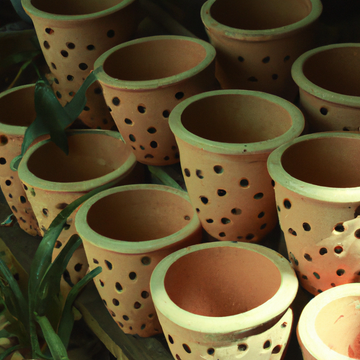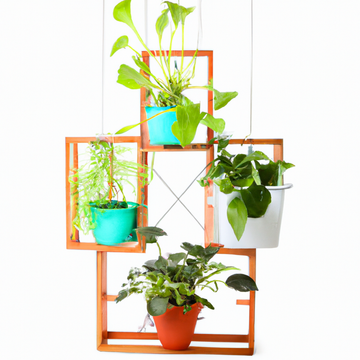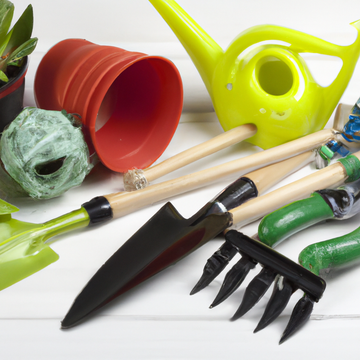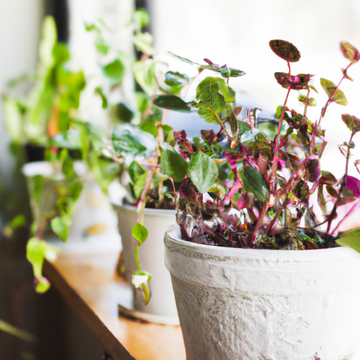Gardening Blog
Choosing the Right Orchid Planters: A Guide
by GOLDDUST- Rethink&Revive on Apr 22, 2023

Orchids are known for their stunning beauty and exquisite fragrances, making them a popular choice among flower enthusiasts. But if you want to keep these delicate plants thriving, choosing the right orchid planters is crucial. With so many options available on the market, it can be overwhelming to decide which type of planter is best suited for your orchid's needs. In this guide, we'll take a closer look at the different types of orchids and the ideal planters that will help them flourish. Whether you're a seasoned gardener or just starting out with your green thumb journey, this article will provide all the information you need to choose the perfect orchid pot!
The Different Types of Orchids
Orchids are a diverse group of flowering plants that belong to the Orchidaceae family. With over 25,000 known species, they come in a variety of shapes and sizes, from miniature orchids that can fit into the palm of your hand to tall varieties with long stems.
One type of orchid is the Phalaenopsis or “Moth Orchid,” which is one of the most popular indoor houseplants due to its ability to bloom for several months at a time. Cattleya orchids, on the other hand, are prized for their large and colorful blooms that come in shades ranging from pink and purple to yellow and orange.
Another fascinating type is Vanda orchids with vibrant colors such as blue! These stunning flowers grow without soil but require high humidity levels and plenty of light. Dendrobiums produce fragrant flowers borne on long-stemmed inflorescences while Oncidiums have cascading sprays with dozens or even hundreds of small blooms per stem!
Whether you prefer classic-looking blooms or more exotic varieties, there's an orchid out there for everyone!
The Best Planters for Orchids
When it comes to finding the best orchid planters, there are a few different factors to consider. The first thing to think about is the material of the planter. Orchids generally prefer pots that are made from breathable materials like clay, terracotta, or even wood. These materials allow air and moisture to flow through easily, which helps prevent root rot.
Another important consideration is size. Orchids thrive in tight spaces, so you'll want to choose a pot that's just big enough for the roots with some room for growth. A good rule of thumb is to pick a pot that's only slightly larger than the one your orchid came in.
In addition to material and size, drainage is also crucial when it comes to selecting an orchid planter. Make sure your chosen pot has plenty of drainage holes at the bottom so excess water can escape easily.
If you're looking for something more decorative than traditional terracotta pots, there are plenty of options available! Just be sure whatever option you choose still meets all the necessary requirements for optimal orchid health.
What is the best location for orchid planter?
When it comes to the best location for your orchid planters, there are a few things you need to consider. Orchids come from tropical rainforests, so they thrive in warm and humid environments with indirect sunlight. Here are some tips on how to choose the right spot for your orchid planter:
1. Sunlight: Indirect sunlight is key when it comes to growing orchids, as direct sunlight can burn their delicate leaves. Place your planter near a window that receives bright but filtered light.
2. Temperature: Orchids prefer temperatures between 60-80°F (15-27°C). Avoid placing them near drafty windows or air conditioning vents.
3. Humidity: As mentioned earlier, orchids love humidity! You can increase humidity levels by grouping plants together, using a humidifier or placing a tray of water near the plant.
4. Airflow: Good airflow is important for preventing fungal growth and promoting healthy roots. Avoid placing your planter in stagnant areas of the house like corners or small rooms.
By following these guidelines, you can create an ideal environment for your orchid planter and ensure that it thrives for years to come!
How to Care for Your Orchid in Its Planter
Caring for your orchid in its planter is crucial to ensure that it thrives and blooms beautifully. Here are some tips to help you care for your precious plant:
1. Watering: Orchids need the right amount of water to survive, but overwatering can be fatal. Make sure to water them only when necessary and allow the soil to dry out completely between watering sessions.
2. Lighting: Most orchids require bright but indirect light, so make sure not to expose them directly under the sun's rays. If your orchid isn't getting enough light, consider using artificial lighting or moving it closer to a window.
3. Temperature: Orchids thrive best at warm temperatures during the day with cool nights, which imitate their natural habitat in tropical regions.
4. Humidity: Orchids love humidity levels between 50-70%, which may be difficult to achieve indoors without a humidifier or misting regularly.
5. Fertilizing: Fertilize only during active growth periods and follow instructions carefully as too much fertilizer can harm an orchid more than no fertilizer at all.
By following these basic guidelines along with specific species requirements, you can successfully care for your orchid in its planter!
What are some common mistakes to avoid when planting orchids in a planter?
When planting orchids in a planter, there are several mistakes that you should avoid to ensure their healthy growth. First of all, using orchid planters without drainage holes can lead to waterlogged soil and root rot. Always make sure the planter has proper drainage before planting your orchid.
Another mistake is choosing a planter that is too small for your orchid's roots. Orchids require enough space for their roots to grow and expand properly. Choosing a container with sufficient room will ensure the plant doesn't become root-bound.
Overwatering is another common mistake when planting orchids in a planter. Although they require regular watering, overwatering can cause damage to the plant's roots and lead to fungal infections or other diseases.
On the other hand, underwatering can also be detrimental to an orchid's growth as it requires consistent moisture levels. Make sure not to let the soil dry out completely between watering sessions.
Placing your new orchid in direct sunlight can harm its leaves and flowers by causing them to burn or wilt. Instead, place it in bright but indirect light where it will receive adequate sunlight without being exposed directly.
By avoiding these common mistakes when planting orchids in a planter, you'll help ensure healthy growth for this beautiful plant species!
How to repot orchids in a planter, and when is the best time to do it?
Repotting orchids is an important task that should be done every one to two years. The best time to repot your orchid is in the spring, right before it enters its active growth phase.
Firstly, gently remove the plant from its current planter and carefully loosen the roots with a sterile tool. Be careful not to break any roots as they are delicate and can easily become damaged.
Next, choose a new planter that is just slightly larger than the old one. It’s recommended to use a clear or translucent planter since this allows you to monitor root growth and check for any issues such as over-watering or disease.
Once you have placed your orchid into its new pot, fill around it with fresh orchid-specific soil mix until it reaches about an inch below the rim of the pot. Firmly pack down the soil but avoid compacting it too tightly as this can prevent proper drainage and air flow.
Water your newly potted orchid thoroughly until excess moisture drains out of the bottom of your planter. Place your plant in a shaded area for several days while it adjusts to its new environment before moving back into its usual spot.
By following these simple steps when repotting your orchids, you ensure their continued health and beauty!
Conclusion
Choosing the right orchid planters is essential to ensure their optimal growth and health. You need to consider various factors like size, drainage, material, and location when selecting a planter for your orchid.
Remember that not all types of orchids require the same type of planter. Some prefer a more porous medium while others prefer something that retains moisture longer. Additionally, there are different materials available on the market such as plastic, clay or ceramic pots.
Always keep in mind that proper care is critical for your plant's survival and growth. Be attentive to its water requirements and avoid common mistakes like overwatering or using dirty containers.
By following our guide on choosing the right pot for your orchid you will be able to provide it with an environment where it can thrive!
Tags:




